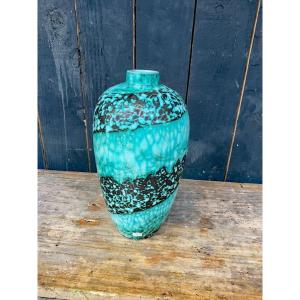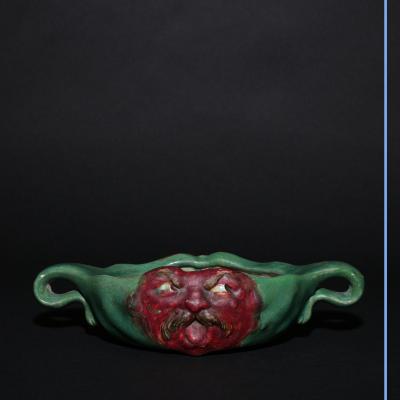Their collaboration is well-known and several busts were made there in grand feu salted stoneware (see last image). This slightly iridescent blue/green enamel is typical of the creations of the master potter Roger Guérin.
The underside of the piece is also typical of R. Guérin's creations. Perfectly executed iridescent enameling and glaze. Ceramic in very good condition, note 3 small chips under the base (see images, red arrows).
Louis-Gustave Cambier (1874, Brussels – 1949, Ixelles).
Painter – Engraver – Sculptor.
Louis-Gustave Cambier, Belgian artist, trained at the Brussels Academy and the Ranson Academy in Paris. He was a pupil of Jean-François Portaels in Brussels, then of Paul Signac in Paris (1893-1897). During this period, he formed friendships with major figures of the Nabi movement, such as Paul Sérusier and Maurice Denis, whose influence is reflected in his early religious compositions, notably his stained glass cartoons. Cambier married Juliette Ziane, a self-taught flower painter and niece of the art critic Octave Maus. She became a pupil of her husband, with whom she shared an artistic career.
During the First World War, the couple resided in Cagnes-sur-Mer, where they met Auguste Renoir. Their numerous travels to Turkey, Asia Minor and Palestine had a strong influence on Cambier's career. In Jerusalem, he met the writer Pierre Loti, who passed on to him his interest in the Orient. This period, often referred to as the “dark period” (until 1905), is illustrated by major works such as:
• The Holy Sepulchre (Ixelles Museum).
• The Millennia (Ghent Museum).
• The Golden Horn (Bruges Museum).
• Russian Pilgrimage to Jerusalem (Brussels Museum).
• The Green Mosque, in Brousse.
In addition to his oriental scenes, Cambier also painted portraits (notably of King Albert and Cardinal Mercier), still lifes, and landscapes inspired by the Meuse Valley, the Sonian Forest, and the Near East. Initially an impressionist, his palette, influenced by Fauvism, gradually evolved towards a more realistic style. He was also a sculptor, producing several busts and portraits.
In 1898, Cambier co-founded the artistic circle “Le Labeur”, demonstrating his involvement in Belgian artistic life. His works are now present in several institutions, including the museums of Brussels, Ghent, Bruges, Liège, and Tournai. In summary, Louis-Gustave Cambier stands out as a leading figure in Belgian art, mixing Impressionist, Fauvist, and Oriental influences in a diverse body of work.


















































 Le Magazine de PROANTIC
Le Magazine de PROANTIC TRÉSORS Magazine
TRÉSORS Magazine Rivista Artiquariato
Rivista Artiquariato